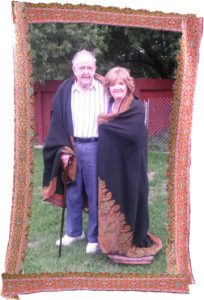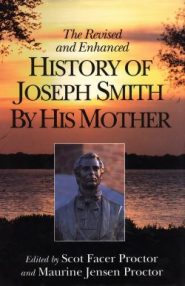https://ldsmag.com/article-1-2543/
By Scot and Maurine Proctor
Editors’ Note: To prepare for the Doctrine & Covenants year of study in gospel doctrine, Meridian will offer you in the weeks to come short excerpts from Lucy Mack Smith’s history of her prophet son Joseph. Considered by scholars to be one of the premier source documents about the restoration, Lucy’s story reads like a novel as she paints vivid pictures of the men and women whose lives were carved out by the significant events. She is fluent and insightful, enduring and passionate as she tells stories we find nowhere else in Church history. You become, as one reader said, “a fly on the wall in the Smith family kitchen†reading Lucy’s story. Few can read this story without feeling poignant emotion for Joseph’s life and death.
Lucy Mack Smith’s history has been available for generations, edited by Martha Jane Knowlton Coray. For the revised and enhanced edition, however, we went back to Lucy’s original raw notes which surfaced again in the late 60’s in the Church archives. Based on these notes, we re-edited a new edition which was much closer to Lucy’s own voice and includes important scenes and soliloquies taken from the original. We also added over 600 footnotes and 100 photographs of the places Joseph knew well to put the story in context.
If there is one book to make you compelled toward Church history during this Doctrine & Covenants study year, this would be it. In this first of a series, we give you the background on how Lucy Mack Smith’s biography came to be. Next week we discuss the controversy that once surrounded it.
It was the bleak midwinter of 1844-45, only months since her sons Joseph and Hyrum had been murdered by a gloating mob in Carthage Jail, when Lucy Mack Smith sat down to tell her life story to a twenty-three-year-old scribe named Martha Jane Knowlton Coray. Lucy was sixty-nine years old, afflicted, as she said, “by a complication of disease and infirmities†and still aching with loss. In the fall of 1840 she thought she had experienced the most misery she would ever know. She recalled: “I then thought that there was no evil for me to fear upon the earth more than what I had experienced in the death of my beloved husband. It was all the grief which my nature was able to bear, and I thought that I could never again be called to suffer so great an affliction as this.†But time had proven her wrong. Her nature would be called upon to bear more. On a June night in 1844, word had come to Nauvoo that her two sons had been murdered and thirty-three days later another son, Samuel, would languish and die of complications arising from being chased on horseback by the mob. Of her six sons who had lived to maturity, five were gone, and with the exception of some sons-in-law, Lucy’s family was reduced to widows and fatherless children.
These weren’t her only losses. Once her son Joseph had received a heavenly vision ahd had learned that he was the prophet to restore the gospel in the latter days, trial had plagued Lucy. She had lost her farm in New York; she had seen her husband imprisoned; she had trudged through an incessant rain on the way to Missouri that reduced her to near death; she had seen soldiers whoop and holler as they dragged her sons to jail with a death sentence on their heads. Of the endless grief, she said, “I often wonder to hear brethren and sisters murmur at the trifling inconveniences which they have to encounter…and I think to myself, salvation is worth as much now as it was in the beginning of the work. But I find that ‘all like the purchase, few the price will pay.’â€
It was a woman who not only was willing to pay the price for her religious convictions, but already had, who sat down with the scribe that winter in Nauvoo. Thus, her history rings with sincerity and deeply-felt emotion. However much others may have doubted and harangued her son Joseph, Lucy had no doubt that he was exactly what he claimed himself to be-a prophet. She had a remarkable story to tell and she told it remarkably-with passion, candor, and fluency. Apart from anything else,, it would be a wonderful story for generations of readers, but beyond that, it gives a personal glimpse of Joseph Smith seen nowhere else. Here is Joseph dealing with excruciating pain during a crude operation on his leg, sick with misery at Martin Harris’s loss of the 116 pages, laying a cloak down on the hard floor night after night to give someone else is bed in Kirtland. Through Lucy’s recollections, we enter the Smith family home, hear their conversations, watch a young prophet beginning to understand that he has a profound destiny. It is a rare thing to have a sustained narrative from the mother of a man who was had such a significant impact on the world.
What’s more, we come to know Joseph better in these pages because we come to know Lucy. To understand his mother is to understand something more about the son. They share the same native flair for expression, the same courage in the face of opposition. They are both high-spirited, deeply loyal to their beliefs, hardworking and intelligent. Most of all, they share a passion to understand who God is and what he expects of them. When Lucy was a young married woman, sick and apparently dying, she made a covenant with God: “I covenanted with God that if he would let me live, I would endeavor to get that religion that would enable me to serve him right, whether it was in the Bible or wherever it might be found.†For Lucy, this began an intense search for the true religion that is echoed in her son’s similar yearnings. Joseph is certainly a product of the mother and home from which he came.
The Preliminary Manuscript
It is not entirely clear who motivated the creation of Lucy Mack Smith’s history. In January 1845, she wrote to her son William that she was constantly answering questions on “the particulars of Joseph’s getting the plates, seeing the angels at first, and many other things which Joseph never wrote or published,†and she had “almost destroyed her lungs giving recitals about these things.†She “now concluded to write down every particular.†In her rough preface to the work she also states that she has been induced to write because “none on earth is so thoroughly acquainted as myself with the entire history of those of whom I speak.†But it is also evident that at the same period Church historian Willard Richards and his staff were working on the Church history up to Joseph’s death and they gave encouragement to Lucy to supply the background only she could give. In that same letter to William, she said, “I have the by council of the 12 undertaken a history of the family that is my father’s family and my own.â€
At any rate, sometime in the early winter, Mother Smith approached Martha Jane Knowlton Coray to be her scribe.
Martha Jane’s husband, Howard remembered the event: “In the fall of 1844, I procured the Music Hall for a school room: it was large enough to accommodate 180 students and I succeeded in filling the room. Sometime in the winter following, Mother Smith came to see my wife about getting her to help write the history of Joseph, to act in the matter only as her, Mother Smith’s amanuensis. This my wife was persuaded to do; and so dropped the school.â€
Ailing or not, Lucy wanted to get this history down, and it appears that she dictated her story to Martha through that winter, who wrote it with clear penmanship, excellent spelling, and little punctuation. Of course, whenever a second person is involved in a work the question arises. What part of the product reflects the personality and style of the author and what part the influence of the scribe? Martha Jane supplies the answer to this. She wrote Brigham Young that because of her practice of note taking, “this made it an easy task for me to transmit to paper what the old lady said, and prompted me in undertaking to secure all the information possible for myself and children….Hyrum and Joseph were dead, and thus without their aid, she attempted to prosecute the work, relying chiefly upon her memory, having little recourse to authentic statements whose corresponding dates might have assisted her.†…
Thus, what Martha wrote down appears to be the raw, unedited Lucy, a reflection of her intellect and heart. What she expressed was her life as she saw it and the part that her family had played in bringing forth the Book of Mormon and the restored religion. It was not originally what it has long been titled, History of Joseph Smith by His Mother, Lucy Mack Smith. It was instead, “The History of Mother Smith, by Herself,†a family history, a story of drama, spiritual adventure, and pathos, but most of all a personal story. Thus, without hesitation, she shared intimate details probed feelings and made assessments, felt free to soliloquize. She was frank, for instance, to say that she looked forward to standing at the bar of God, where after a lifetime of persecution, justice will finally reign and her persecutors will be brought to task. And though she shared her suffering, she was not full of self-pity, but rather grateful to be the mother of a prophet and part of a transcendent work…
During 1845, Howard Coray turned over his school to others and joined his wife, Martha Jane, in a labor to revise the Preliminary Manuscript. Howard had been one of Joseph Smith’s clerks, whose assignment included compiling the official historical record of the Church. Together they substantially revised the Preliminary Manuscript. This was not merely a job of correcting grammar or changing and clarifying confusing chronologies. It has been suggested that “about one-fourth of the revised manuscript is not in the preliminary draft, while approximately ten percent of the earlier manuscript is omitted from the revised manuscript.†What was added in the revision was information designed to make it a more balanced and complete history, as well as expand the information on Joseph Smith’s own version of the First Vision and Moroni’s first visit were included. Additional information was added from “The History of Joseph Smith†published earlier in the Times and Seasons. Gaps were filled, necessary explanations added. While Mother Smith was probably frequently consulted during the entire composition, and she clearly gave her approval to the final version, certainly her biggest contribution had already passed.
It is not surprising, then, to observe that while the revised version had strengths lacking in the Preliminary Manuscript, it is also further from Lucy’s own voice. The Corays deleted many of her soliloquies, they axed intimate details of family life and affectations, they sometimes avoided emotions, they polished her phrases. Unfortunately, comparing the Preliminary Manuscript with the revised version, it is clear that this is not always a favor. The Corays’ edits led to a more fussy, formal speech pattern than Lucy is given to. Ironically, their changes sound old-fashioned to the modern ear, as opposed to Lucy’s more direct speech. But it is the moving from Lucy’s perceptions and feelings that is the greater loss.
The work of revision appears to have been finished by the end of 1845, for on the afternoon of November 19, 1845, the Twelve discussed the need to “settle with Brother Howard Coray for his labor in compiling†Lucy’s history, and a settlement was made in January 1846. The Twelve’s financial support and long interest in the project certainly made them feel that the Church had a vested interest in it.
Though Lucy was anxious that the manuscript be published, the end of 1845 found the Church with two other projects that consumed the energies and resources of the Saints. Their enemies had never let off the persecution. They had formed “wolf packs†to hunt the Saints; they had burned homes beyond Nauvoo, sending a flood of refugees into the city; they had harassed the Twelve with lawsuits and now Nauvoo had been turned into a workshop to build wagons to flee the city. Packing to leave everything they owned while they continued to build a temple absorbed the Saints that winter, and Lucy’s manuscript naturally took a backseat.



